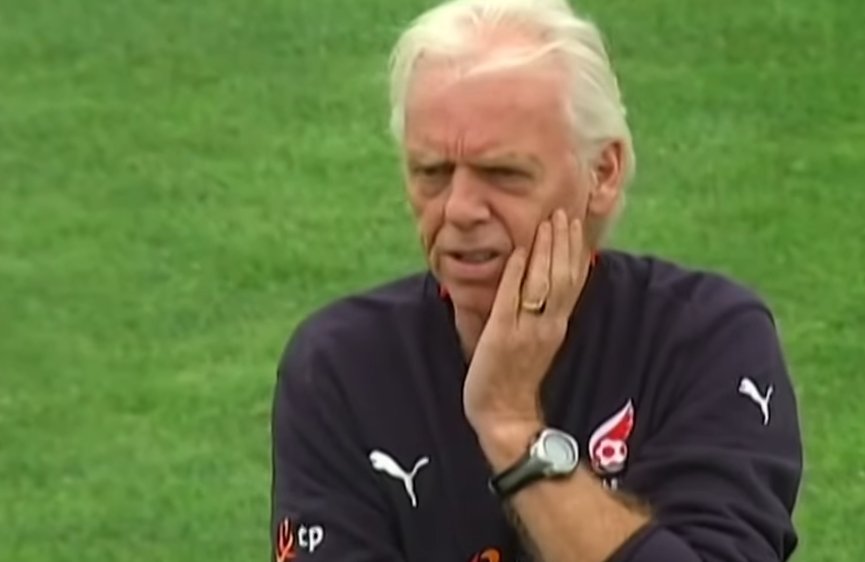Like a grand strategist scouting a board, he read the pitch and ordered sidelines with the quiet authority of an experienced chess master. Leo Beenhakker, however, carried a quiet loyalty behind every change in formation and every triumph that astounded top opponents. Despite being mostly absent from press columns, this partner’s presence was felt deeply throughout his lengthy career. Football laments the recent death of this Dutch strategist at the age of 82, and there is a renewed interest in the woman who walked with him despite the spotlight of international praise.
Beenhakker’s wife, who was only occasionally spotted in public, epitomized the art of polite anonymity at a Dutch Eredivisie game in April 2019. Getty Images’ photograph of them together is remarkably reminiscent of the last brushstroke in an oil painting: subtle yet powerfully emotional. It says a lot about a relationship based on lasting presence rather than show. Even though many modern football families join the brand, she chose to remain anonymous rather than take center stage, which feels unusual and incredibly successful in this era of carefully manicured personas.
Leo Beenhakker’s Life and Career Summary
| Attribute | Details |
|---|---|
| Full Name | Leo Beenhakker |
| Date of Birth | 2 August 1942 |
| Date of Death | 10 April 2025 |
| Place of Birth | Rotterdam, Netherlands |
| Partner/Wife | Name not publicly disclosed (confirmed presence in media photo, 2019) |
| Primary Role | Football Coach and Technical Director |
| Key Teams Managed | Real Madrid, Ajax, Feyenoord, Club América, Poland, Trinidad & Tobago |
| Notable Achievements | 3x La Liga (Real Madrid), Euro 2008 (Poland), 2006 World Cup (T&T) |
| National Decorations | Chaconia Medal (Trinidad & Tobago), Order of Polonia Restituta (Poland) |
| Nickname | “Don Leo” (Known for charm, cigars, and dry wit) |
| Verified Source | Wikipedia – Leo Beenhakker |
Football culture over the last few decades has placed a strong emphasis on visibility. Families are featured prominently in lifestyle coverage, coaches endorse books, and athletes discuss locker room customs. However, the dynamic between Leo and his spouse remained exquisitely resilient to this shift. She provided continuity while he was making chalk lines in Madrid’s locker rooms or planning Trinidad and Tobago’s defense, subtly stabilizing him in the tactical chaos of elite football.

Beenhakker was already legendary in coaching circles by the time he guided Poland to their first-ever appearance at the UEFA European Championship in 2008. His private life, however, was safely shielded from every headline—possibly as a conscious gesture of respect rather than out of necessity. This deliberate decision contrasts sharply with the contemporary merging of family and celebrity, where intrusion frequently results from public interest. In addition to being unusual, his wife’s determination to remain behind the camera was very admirable.
Their relationship served as a startling reminder that intimacy doesn’t have to be performative during the pandemic years, when even the most private lives became more digitally exposed. Her decision to abstain from interviews, Instagram posts, and legacy documentaries was motivated by her values. She opted for presence over persona, while other celebrities took advantage of viral visibility. She did this by redefining what supportive relationships for public figures can entail.
By making calculated career choices, Beenhakker frequently made a comeback in teams and countries with lower footballing status, such as Saudi Arabia, Hungary, and Trinidad and Tobago, where football was still an aspiration rather than a religion. His personal relationship remained remarkably intact during these changes, which is incredibly telling. Their marriage appears to have the emotional fortitude that many famous couples find difficult to sustain, as it withstood culture shocks, bureaucratic entanglements, and constant relocation.
This emotional consistency becomes even more important when considering international coaching circuits. In contrast, individuals such as José Mourinho and Louis van Gaal frequently garnered media attention for both their family’s portrayal in the media and their professional antics. The fact that Beenhakker refused to feed that machine says a lot about his values and, consequently, those of his partner.
In his professional life, he was frequently praised for transforming weaker teams into formidable rivals. Beenhakker’s coaching was notably inventive and consistently bold, from turning Club América into a title contender to leading tiny Trinidad and Tobago to a historic draw against Sweden at the 2006 World Cup. Although it may not have been documented in football journals, his wife’s unwavering support during these high points—particularly as he negotiated disparate languages, sports cultures, and expectations—reverberated behind every tactical board.
A different kind of romance, one based on discretion, perseverance, and mutual independence, is represented by Leo and his partner in a time when relationships are frequently publicized before they are even formed. Their love story was strong enough without the need for a hashtag. And maybe that’s what gave it its exceptional durability.
Her words probably would have presented a more gentle, vulnerable image of the man whose keen wit and cunning mind were frequently characterized as frightening if she had decided to speak out after his passing in April 2025. However, she didn’t. She stepped back in death, letting his career’s legacy speak for itself in a quiet, impactful, and respectful manner, just as she stood by him in life without demanding the camera’s attention.
Football fans have witnessed numerous partners embrace the spotlight over the years, from Georgina Rodríguez’s ascent alongside Cristiano Ronaldo to Shakira’s presence next to Gerard Piqué. Beenhakker’s wife, on the other hand, decided not to ride the fame wave, demonstrating that constant support can be especially helpful without ever coming across as performative. Her love was lived, not staged.
She gave us all something unique by leading a life free from media attention: a picture of devotion that didn’t require headlines. This long-standing connection challenges us to reconsider what it really means to be present, even as media platforms are increasingly influenced by what is seen and shared. After all, presence isn’t always audible.


